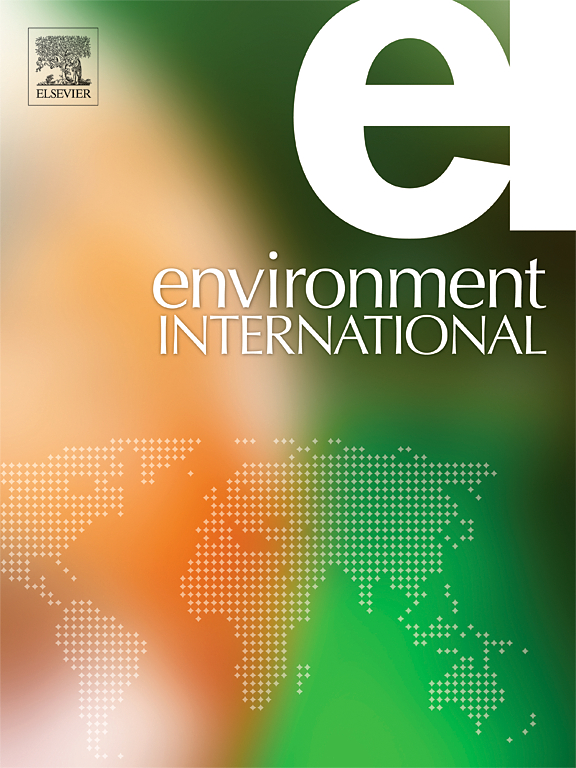Combination of suspect and nontarget screening with exposure assessment for per- and polyfluoroalkyl substance prioritization in Chinese municipal wastewater
IF 10.3
1区 环境科学与生态学
Q1 ENVIRONMENTAL SCIENCES
引用次数: 0
Abstract
Municipal wastewater treatment plants (WWTPs) are significant sources of per- and polyfluoroalkyl substances (PFASs) in aquatic environments, making their identification and priority rank crucial for risk control. Wastewater samples were collected from 148 municipal WWTPs in China to determine the occurrence and risk prioritization of PFASs. A total of 61 PFASs were identified, including 14 legacy and 47 emerging PFASs, using machine learning prediction-enhanced suspect and nontarget screening techniques. PFASs were detected in all wastewater samples, with perfluorocarboxylic acid (PFCA), perfluorosulfonic acid (PFSA), fluoromeric sulfonic acid (FTSA), and perfluoroalkyl sulfonamide-like (PFSM) substances being the predominant classes. The exposure loads of legacy and emerging PFASs to the Chinese population were 71.8 and 52.9 μg·day−1·people−1, respectively, and textile and clothing products might be the primary PFAS exposure pathways. Through a risk prioritization method integrating toxicity and exposure data, ten legacy and five emerging PFASs were flagged as high-priority substances requiring additional attention. As the PFAS risk removal efficiency by conventional biological treatment processes was only 0.7 %, the PFAS risk priority patterns in influent and effluent were similar (r = 0.86, p < 0.01). In addition, there were significant regional differences in the PFAS risk distribution, and the PFAS risk in eastern China was higher than that in other regions. This study offers novel insights for the identification and priority control assessment of PFASs and other emerging environmental contaminants.


中国城市污水中全氟和多氟烷基物质优先排序的可疑和非目标筛选与暴露评估相结合
城市污水处理厂(WWTPs)是水生环境中全氟烷基和多氟烷基物质(PFASs)的重要来源,因此它们的识别和优先排序对风险控制至关重要。收集了中国148个城市污水处理厂的废水样本,以确定PFASs的发生情况和风险优先级。使用机器学习预测增强的可疑和非目标筛选技术,共确定了61个PFASs,包括14个遗留PFASs和47个新出现的PFASs。在所有废水样品中都检测到全氟磺酸,其中全氟羧酸(PFCA)、全氟磺酸(PFSA)、氟聚磺酸(FTSA)和全氟烷基磺酰胺样(PFSM)物质是主要类别。中国人群中遗留PFAS和新发PFAS的暴露负荷分别为71.8和52.9 μg·day - 1·people - 1,纺织品和服装产品可能是PFAS的主要暴露途径。通过综合毒性和暴露数据的风险优先排序方法,将10种遗留全氟辛烷磺酸和5种新出现的全氟辛烷磺酸标记为需要额外关注的高优先物质。由于传统生物处理工艺对PFAS的风险去除效率仅为0.7 %,因此进水和出水PFAS风险优先级模式相似(r = 0.86,p <; 0.01)。此外,PFAS风险分布存在显著的区域差异,中国东部地区PFAS风险高于其他地区。本研究为全氟磺酸和其他新兴环境污染物的识别和优先控制评估提供了新的见解。
本文章由计算机程序翻译,如有差异,请以英文原文为准。
求助全文
约1分钟内获得全文
求助全文
来源期刊

Environment International
环境科学-环境科学
CiteScore
21.90
自引率
3.40%
发文量
734
审稿时长
2.8 months
期刊介绍:
Environmental Health publishes manuscripts focusing on critical aspects of environmental and occupational medicine, including studies in toxicology and epidemiology, to illuminate the human health implications of exposure to environmental hazards. The journal adopts an open-access model and practices open peer review.
It caters to scientists and practitioners across all environmental science domains, directly or indirectly impacting human health and well-being. With a commitment to enhancing the prevention of environmentally-related health risks, Environmental Health serves as a public health journal for the community and scientists engaged in matters of public health significance concerning the environment.
 求助内容:
求助内容: 应助结果提醒方式:
应助结果提醒方式:


